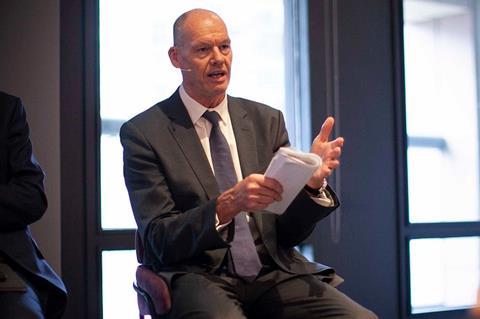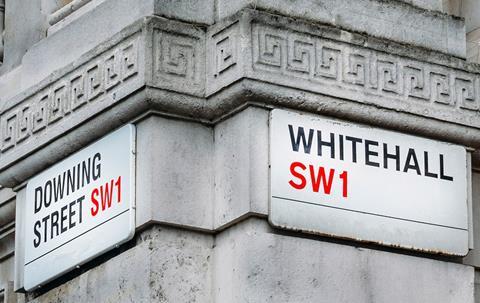As the CLC publishes its latest bi-annual report, Carl Brown speaks to Mark Reynolds about the group’s achievements to date and future plans

“We’ve seen Jeremy twice.” In this case the Jeremy in question happens to be Jeremy Hunt. And “twice” refers to the number of meetings that Mark Reynolds, as co-chair of the Construction Leadership Council, has had with the chancellor of the exchequer in the past five months.
Access to the Treasury – as well as to ministers and senior civil servants in other departments – reflects the growing influence of the CLC as it seeks to put construction’s case as a driver for economic growth.

Today marks an important milestone for the , and Reynolds is keen to talk about the council’s achievements to date and what it wants from the next government, a very relevant discussion given ��ɫ����TV’s focus on the forthcoming general election this year.
The interview takes place in the heart of the City of London at the head office of Mace, where Reynolds is CEO. Before he dives into the CLC’s current and future plans, Reynolds takes a moment to look back to what he considers the pivotal moment of change for an organisation formed in 2013.
>>Click here for more on ��ɫ����TV’s election focus
That moment, he says, was the shock and disorientating fallout of the pandemic. Reynolds says the CLC was initially, under the leadership of then co-chair Andy Mitchell, planning to make net zero its core theme, before the pandemic hit, prompting it to respond by setting up a covid taskforce.
How CLC stepped up during covid
“The taskforce came about by literally five or six people emailing each other on a Sunday night saying CLC needs to step up here,” he says.
“And fair play to Andy, he responded in a positive way, unlike the way the CLC responded during Carillion, when I felt it should have responded but didn’t.”
The move prompted the CLC to bring in trade associations as supporters to help co-ordinate information to businesses forced to operate in what Reynolds terms “survival mode”.
“The thing around covid was about site operating procedures, working closely with industry,” says Reynolds. The CLC started holding council meetings and has held 250 in the four years since.
He says that without the support of the Department for Business and Trade (or BEIS as it was then), the CLC would not have “existed as it does today”. “We wouldn’t have the support, the secretariat and the connectivity with government,” he adds.
Access to ministers
These days the CLC has “good access” into government departments, Reynolds says – not just DBT through construction minister Nusrat Ghani, who is the co-chair on the CLC, but also the Department for Levelling Up, Housing and Communities and the Department for Education. This has been bolstered by better access to the Treasury over the past 18 months, including the aforementioned two meetings with Jeremy Hunt.
But to what extent has the CLC actually influenced policy?
Reynolds says the council does “take the credit” for changes of direction by the government in some areas. He says the CLC’s work with the Treasury secured vital changes to new research and development tax credit rules on subcontracting due to come in this month.
In its biannual report, the CLC says that this saved industry “hundreds of millions of pounds” and Reynolds says it averted a “train wreck for our sector”.
The CLC has also said it secured commitments from the government in the autumn statement for £110m to offset nutrient neutrality, £32m to tackle planning backlogs and a two and a half year target for infrastructure projects to get consent.
Reynolds says that he suggested to the Treasury that it publish a consultation on plans for an accelerated planning service for major commercial applications earlier this month. “All we said in the meeting was, ‘Jeremy give yourself some cover, we need to sort this out. Go out and do a consultation, get the feedback’.”
These areas of progress, while perhaps limited in scope, are all part of a bigger picture – one where the CLC has larger ambitions. In 2022 the council announced four key priorities for the years ahead: building safety, people and skills, net zero and bio-diversity and next generation delivery.
Last year it appointed four industry sponsors to lead the CLC’s work in these areas (see box below), each of whom also sits on the CLC board.
CLC’s board
| Board member | CLC role | Day job |
| Nusrat Ghani MP | co-chair | construction minister |
| Mark Reynolds | co-chair | group chief executive, Mace |
| Richard Robinson | deputy co-Chair | President, UK & Europe, AtkinsRéalis |
| Fergus Harradence | board member | deputy director for construction, Department for Business and Trade |
| Isabel Coman | industry sponsor – Next Generation Delivery | director engineering and asset strategy, TfL |
| Stephen Dance | board member | head of infrastructure delivery, Infrastructure and Projects Authority |
| Matt Palmer | Industry sponsor – net zero and biodiversity | programme director, Lower Thames Crossing |
| Nick Roberts | industry sponsor – people and skills | chief executive, Travis Perkins |
| Karl Whiteman | industry sponsor – building safety | divisional managing director, Berkeley Group |
Cutting across these key priorities, says Reynolds, is “planning, pipeline and people”. Taking these in order, planning remains a large frustration to the co-chair, as indeed it is to many people in the CLC and wider industry.
As an example, Reynolds says: “We [Mace] did a brilliant job setting up the prisons programme. We had a programme manager, integrated supply chain… it was with four other contractors [ISG, Kier, Laing O’Rourke and Wates] and the MoJ.
Planning frustrations
“It was a really good programme. But every prison has been stalled for between one and two years. Why? Because nobody wants a prison in their backyard. It always gets shoved up to the secretary of state, who eventually approves it.”
The CLC will continue to work with the government to bring flexibilities into aspects of the planning system, and Reynolds has a clear idea about what needs to happen to change the situation.
“We want to ensure that these big programmes that have been identified fit within the overarching planning constraints of UK plc and also the local planning constraints,” he says. Reynolds believes the National Infrastructure Assessment published by the National Infrastructure Commission last October is a “great visionary document” but can’t easily be delivered because of planning constraints.
“I think we need a UK national planning authority,” says Reynolds, stressing that this is a personal view. “It needs to be arms-length to government and sit within a strategic framework.”
I think we need a UK national planning authority
He bats away the opposing view that such an approach would amount to an errosion of local democracy. “Look, nuclear power stations – are they going to go ahead? Yes they are. So why put ourselves through that?” he asks.
“Why not just say, ‘we’ve got the NIC with a national planning authority, to deal with this big picture stuff’? These programmes need clarity.”
Clarity over, and visibility of, future pipelines of work is a major ask of the CLC. “If you can deliver with certainty, you will get investment. People will start investing in skills, plant and equipment,” Reynolds says.
Visibility of pipeline
He was disappointed with last month’s long-awaited national infrastructure pipeline document, calling it a “missed opportunity”. In common with many others in the industry, Reynolds felt it did not have enough in it. He reckons about “£30bn of investment was not included”.
Instead the CLC is working on an alternative, aimed at more easily enabling construction firms to see upcoming work. “What’s the solution? Let’s work together, using technology, to have an open-source online pipeline tool you can see, and we are developing this at the CLC,” he says.
The third “P” mentioned by Reynolds is people and skills, and the CLC has been working with the Construction Industry Training Board to deliver 26,000 taster sessions in schools.
Interestingly Reynolds says: “The construction sector does not have a recruitment challenge; it has an absorption challenge.” He says that, for every electrical apprenticeship, there are 200 applicants. “We have a great industry, and we have lots of people who want to join it, more than you think.”
There are, however, those “blockers in the system” which prevent certainty of work and deter employers from hiring.
On skills, the CLC also launched 30 competence frameworks to help firms and individuals demonstrate compliance with the labyrinthine ��ɫ����TV Safety Act.
The construction sector does not have a recruitment challenge; it has an absorption challenge
Indeed, more broadly, the bi-annual report demonstrates the sheer amount of work that the CLC has done in the building safety space. Activities have included convening meetings between DLUHC, the BSR and the Office for Product Safety and Standards to raise awareness of building safety issues, delivering workshops and webinars, providing information for industry and helping to shape policies around second staircase requirements and mandatory occurrence reporting for safety issues affecting higher-risk residential buildings.
The CLC has set up a cross-industry “regularity clarity” group. Reynolds says: “It is working really closely with DLUH and BSR, so that when regulations come out, they are workable or we are giving them feedback. If we go back over the past 18 months, it has been a real challenge.”
Reynolds says that the group now reports to Dame Judith Hackitt’s industry safety steering group every six months on its progress and “where it has needed help, it had help [from the government]”. The ultimate aim is for building safety to become more like health and safety in the way it is understood and adhered to in the industry. But, in the short term, “we need to sort out the regulations still”.
Whereas the CLC’s building safety work has been in large part about achieving regulatory clarity, when it comes to net zero a major emphasis has been on measuring the industry’s progress. The CLC says 220 companies have now signed up its CO2nstructZero programme, which provides quarterly performance framework updates to help highlight where more action is needed.
If you really want people to decarbonise you don’t march people up to the top of the hill and then change
From the government, Reynolds’ message is again about the need for clarity and certainty. He is critical of the prime minister’s decision last year to push back the ban on new oil-fired heating systems in homes from 2026 to 2035, and of the decision to delay the ban on new petrol and diesel cars by five years to 2035.

“If you really want people to decarbonise, you don’t march people up to the top of the hill and then change. I can understand why it was done in political terms, but that element of change to automotive and to housing isn’t helpful,” he says
“It’s even less helpful for boiler manufacturers, who have geared up to make these heat pumps and put new business plans in place for 2025 or 2026 only for the requirements to be pushed back.”
Pre-election thoughts
So, Reynolds is certainly not afraid to criticise the current government, and in the run-up to the election the CLC is certainly speaking to Labour. Reynolds himself, in his capacity as chief executive of Mace, has joined an expert advisory panel advising Labour’s review of infrastructure, led by shadow chief secretary to the Treasury Darren Jones.
Regarding the election and the question of who might form the next government, Reynolds, says: “From a CLC perspective, we are going to be agnostic about it of course.
“We are going to tell them [the parties] what we think they should do. They will decide what they do and put it in their manifestos, we will encourage them to be bold and brave and, if they are not, we will be saying it’s a missed opportunity.”
>>
But again, the CLC’s big vision, as explained by Reynolds, is about “getting planning right to unleash a lot of things. Get the pipeline right and use the NIC assessment to drive the big changes.”
The themes again and again are around long-term certainty and clarity. This chimes with A Long-Term Plan for Construction, the ��ɫ����TV the Future Commission’s report in January, published by ��ɫ����TV, which called for certainty over the pipeline of infrastructure work.
The CLC has calculated that building confidence in the project pipeline could unlock investment in partnership, skills and innovation and ultimately boost productivity to the tune of an additional £45bn of added value to the UK every year.
As the political parties ramp up their election campaigns, the industry will want that investment message to stick. Whoever wins at the polls, the job of the CLC remains to have the ear of those in power – and to continue to put the case for construction.
Election focus

As thoughts turn towards the next general election, the UK is facing some serious problems.
Low growth, flatlining productivity, question marks over net zero funding and capability, skills shortages and a worsening housing crisis all amount to a daunting in-tray for the next government.
This year’s general election therefore has very high stakes for the built environment and the economy as a whole. For this reason,
��ɫ����TV is launching its most in-depth election coverage yet, helping the industry to understand the issues in play and helping to amplify construction’s voice so that the government hears it loud and clear.
We kicked off with the first piece in a three-parter looking at the state of play across three key topic areas, namely project delivery, housing and planning, net zero. Part two, looking at building safety, affordable housing and skills and education, is here.
��ɫ����TV is investigating the funding gaps facing the next government’s public sector building programmes, looking at the policy options available to the political parties.
In the coming months our ��ɫ����TV Talks podcast will focus on perhaps the hottest political topic: the housing crisis. The podcast will feature interviews with top industry names who side-step soundbites in favour of in-depth discussions.
As the main parties ramp up their policy announcements, we will keep you up to date with their latest pledges on our website through our “policy tracker”.


























No comments yet